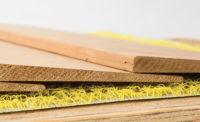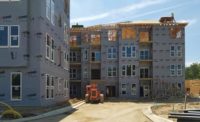In a world full of acronyms, most of us know that WRB stands for water-resistive barrier or weather-resistant barrier. The WRB world was once simple and straightforward. Today, it is anything but that. We went from limited choices; basic installation to a smorgasbord of options coupled with complex installation standards. It seems the world of the WRB is likely to get more complex.
For plastering contractors, that complexity is doubled because we have some special rules in Chapters 25 of the International Building Code and Chapter 7 of the International Residential Code for one- and two-family dwellings. A look back at history may help explain where we are and where we are going.
First: It was asphaltic felt—but felt had a few issues for cement plaster. While very resistant to passage of bulk water, they can lack vapor permeability. Felts also do not bend or fold well, as they can crack in cold weather. This is fine for roofs as they are flat but walls often have lots of ins-and-outs.
The wall and ceiling industry responded with asphalt-saturated Kraft paper. Cost was kept low and this new paper could fold easily around corners. Other benefits were increased vapor permeability and plaster did not tend to bond to asphaltic papers. It was then discovered that black paper would wrinkle slightly when wet. Applying wet cement plaster resulted in slight waves that formed on the backside of the stucco and allowed water to weep down between the cement and building paper.
Life Was Simple and Good
Wood-based sheathing came along and plasterers noted more cracking than normal when cement plaster was applied to these wood-based panels. A friend who was instrumental in code development during the 1970s and ’80s told me that plasterers then started using two-layers of asphaltic paper for walls with wood-based sheathing. They noted the cracking was greatly reduced. He and others made a code proposal to the Uniform Building Code and it was adopted in 1982 as section 4706(d): to apply two layers of asphaltic paper over wood-based sheathings. The "why it reduced cracking" was discovered a few years later.
The top layer of paper would wrinkle as it always had; this created a space that prevented the base layer of paper from getting saturated. This in turn kept the wood sheathing drier than a single layer of WRB paper. The wood sheathing was kept drier and helped prevent the wood from swelling or warping. This swelling was known to crack fresh or green cement plaster. Life was good again.
Unfortunately, when the recession of the early 1980s hit, many left our industry and the boom of the late-’80s saw new workers come in who were never taught basic flashing principles. This created a plethora of leaky buildings and an opportunity for others.
Things Changed
New products and complex flashing procedures popped up all over. Codes and standards followed in an attempt to keep up with all the changes. The drainage mats were just one of the changes and they did reduce leaking. Many believed the reduced leaks were more about a heighted attention to flashing than creating a measured air gap.
Today, the new codes for cement plastering are very focused on the two-layers of building paper and the drainage mats. The U.S. has three Climate Zones: labeled as A, B and C.
- A is moist
- B is dry; and
- C is marine
The location of your project can determine if you need a drainage mat. But this is the simple stuff. What about using a wrinkled house wrap or a layer of foam? Can one use a thinner drainage mat than the code’s prescribed 3/8-inch mat?
The answers are not so simple. When we add the building department into the equation, will they enforce this? If they fail to, is the plastering contractor liable? What about one-coat stucco? How does that play into the role? The new 2021 code on Climate Zones and cement plaster are likely to be a game changer. It is also rumored that the committee who got this language into the code is pushing for all claddings to follow suit.
The cement plaster industry (stucco) is one of the oldest crafts in the United States and is not likely to go away. The Stucco Manufacturers Association has published a technical paper to help designers, suppliers, contractors and even building departments navigate this confusing language. Designers and code authorities are very nervous about risk. The SMA has been providing classes to designers and code authorities to help them keep projects on track and manage the potential risk. Walls & Ceilings readers are encouraged to download this technical paper at stuccomfgassoc.com and keep it handy as you bid cement plaster work. You should also be aware if you are working in Climate Zone A, B or C,that when you start a cement plaster project to protect yourself.






Report Abusive Comment